One of a fair few potential heirs to Diego Maradona, Juan Roman Riquelme was in the lead to that very title as Argentina embarked on their 2006 World Cup campaign. Enjoying good form in the qualifying round, and for La Liga side Villarreal, Riquelme was arguably the world’s best playmaker going into the tournament, and proved instrumental in Argentina’s surge to the quarter-finals.
But in a tight match with hosts Germany, coach Jose Pekerman, after 72 minutes and his side dangerously leading 0-1, decided to substitute Riquelme for Esteban Cambiasso to tighten the ship. Argentina went from outgoing to conservative, and after 79 minutes, lost their slim lead, and were eventually knocked out, losing 4-2 to Germany on its dearest friend, penalties.
What could have been. Argentina were one of the favourites to win the World Cup that year, and excelled in the group stages. Riquelme was the orchestrator behind an entertaining team put together by a coach who, although made that change against the Germans, should not have his largely positive spell marred by that. Riquelme still displayed why he is revered as one of the games great and last classic no.10s.
Riquelme was an Enganche; how Argentines describe the link between midfield and attack, and performed that role to a tee for the national side. Languid and slow-moving, yet graceful with a speed of mind, Riquelme roamed the midfield, looking to receive the ball and create space and chances for teammates.
Pekerman took over from Marcelo Bielsa as coach in 2004, and whereas Bielsa set up the side in a 3-3-3-1 like that seen more recently at Leeds United, Pekerman deployed a 4-3–1-2. Captain and first-choice left-back Juan Pablo Sorin was attack-minded, and typically advanced higher up the pitch than the right-back. The midfield quartet was very technical, with Javier Mascherano anchoring, Cambiasso or Lucho Gonazales acting as box-to-box types, Maxi Rodriguez could play on either the right or left and made runs into the opposition penalty area. Riquelme was expected to supply passes to two mobile forwards; ranging from Javier Saviola and Hernan Crespo, to Carlos Tevez and teenage sensation Lionel Messi.

When attacking in the opposition’s half, the shape itself was quite fluid, with players rotating and making runs into different positions. Riquelme had runners around him, which meant he had an array of options to choose from when on the ball. It suited his tendency to not carry the ball forward as much as play through balls in behind defensive lines. But Riquelme could also drop deeper to offer a passing option for the defence and build attacks from deeper positions. Pekerman’s system got the best out of Riquelme, similarly to the case at Villarreal.
Argentina were dominant in Group C, winning two very convincingly and drawing one, putting them in good stead for the knockout stages. The opening game against Ivory Coast provided a 2-1 win, and Riquelme was potent with his passing. He started the game in a position more towards the left rather than dead central, before moving further inside. Riquelme was given the time and space by Ivory Coast to hold onto the ball which meant he could assess his options, and recycle attacks if he saw fit.
Riquelme was not the quickest, and tended not to make long sprints, but he was always moving, notably out of cover shadows to receive passes and then turn and move the ball forward, which meant Argentine attacks progressed up the pitch with relative ease.
And the first goal of the game showed off Riquelme’s threat from dead-ball situations, which would remain throughout until Argentina’s exit. Argentina won a free-kick on the left-wing, and Riquelme played a delivery into a space in the penalty-area where the ball could be attacked.

A header forced a save from Ivorian goalkeeper Jean-Jacques Tizie. But Crespo pounced to score via a rebound.
Although Ivory Coast had chances of their own, Argentina were largely dominant, and doubled their lead before half-time. An attack was quickly stopped and then began by Argentina. Riquelme exchanged passes with Maxi. As he received the ball returned to Riquelme, Saviola began making a run on the blindside of the nearest defender. Riquelme set up that run with a sublime through ball, which split the Ivorian defensive line.
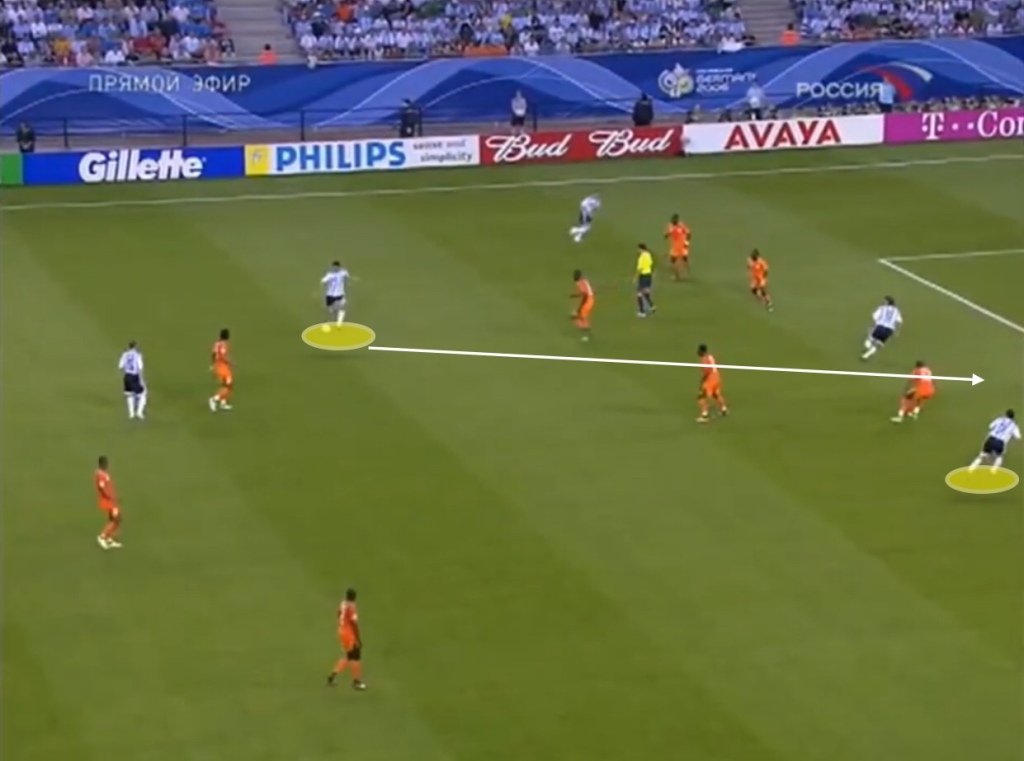
Saviola timed his run, so that when going beyond the defensive line he remained onside, before knocking the ball past the on-rushing goalkeeper.
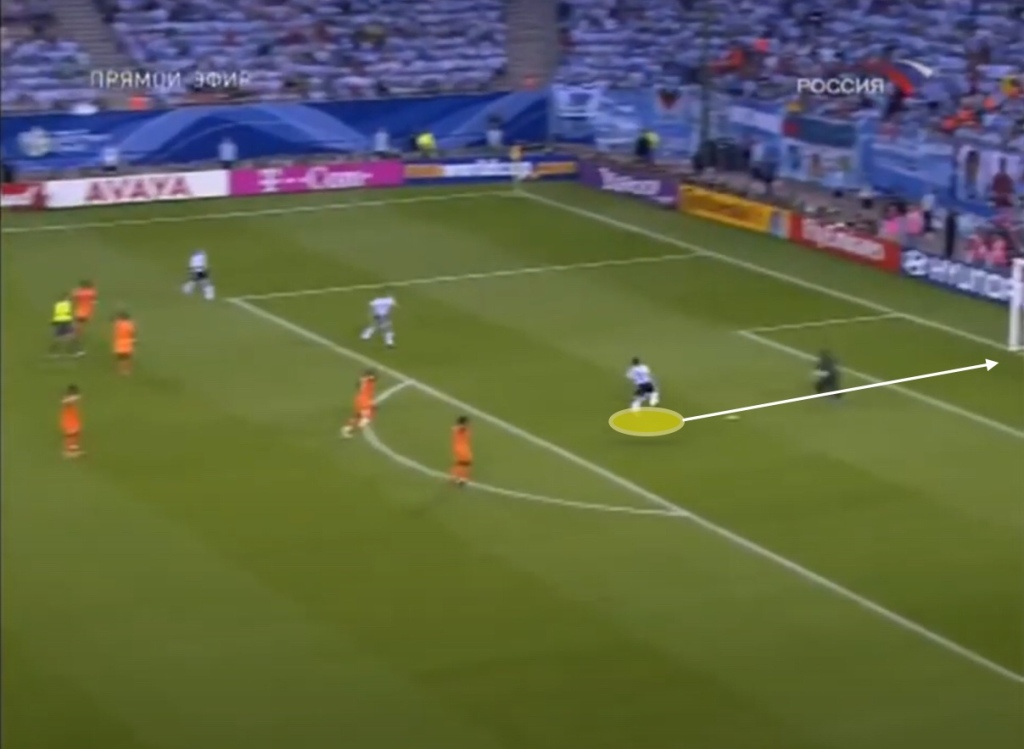
The Ivorian defenders were caught ball-watching, not focused on the runs through gaps in the line from either forward, but instead focused on Riquelme. The defence was not drawn out of position, but Riquelme was not closed down, so he had time to pick the pass, but had to play the pass before Saviola moved beyond the last man. Not only was it pleasing on the eye, it was a well-worked goal, and summarised the roles of both no.10 and forward.
As well as making runs in behind defensive lines, the forwards would also drift wide. This way they could stretch the opposing defence, and even exploit spaces out wide and attack from there, where they could be picked out by a pass from Riquelme.
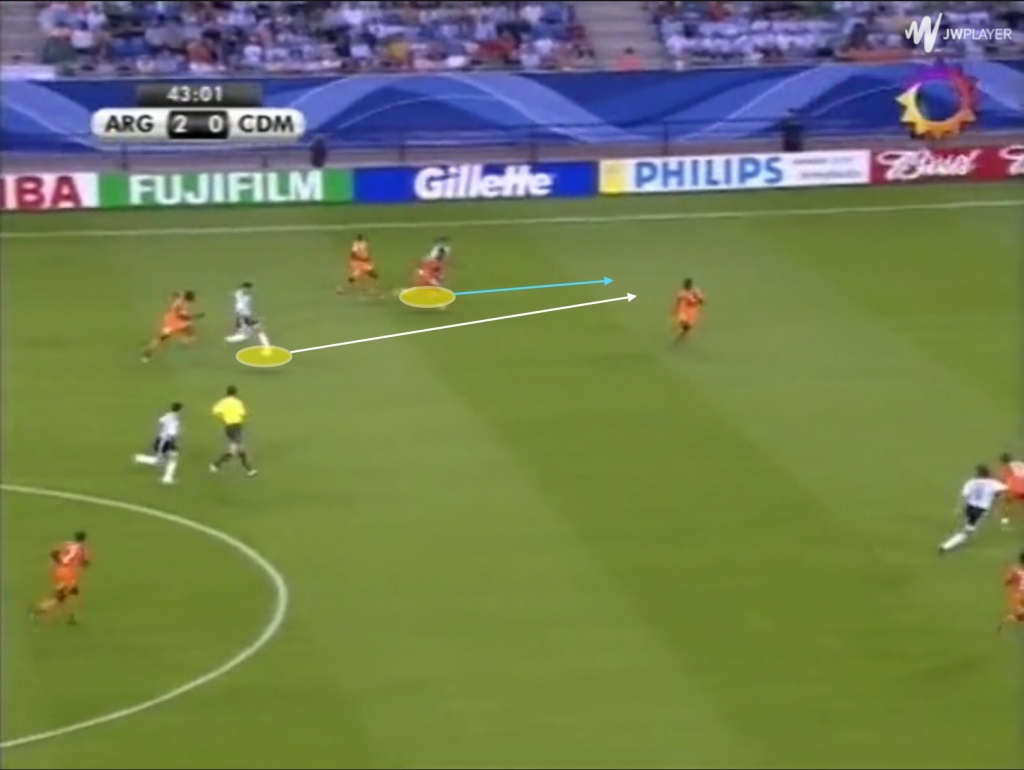
Not that they did all of the hard work, but the forwards mobility did enhance Riquelme’s threat in transitions. Riquelme may not have went on mazy dribbling runs like other Argentines; Maradona, Pablo Aimar, Messi, but he had the cleverness to spray passes into the channels that running could make use of.
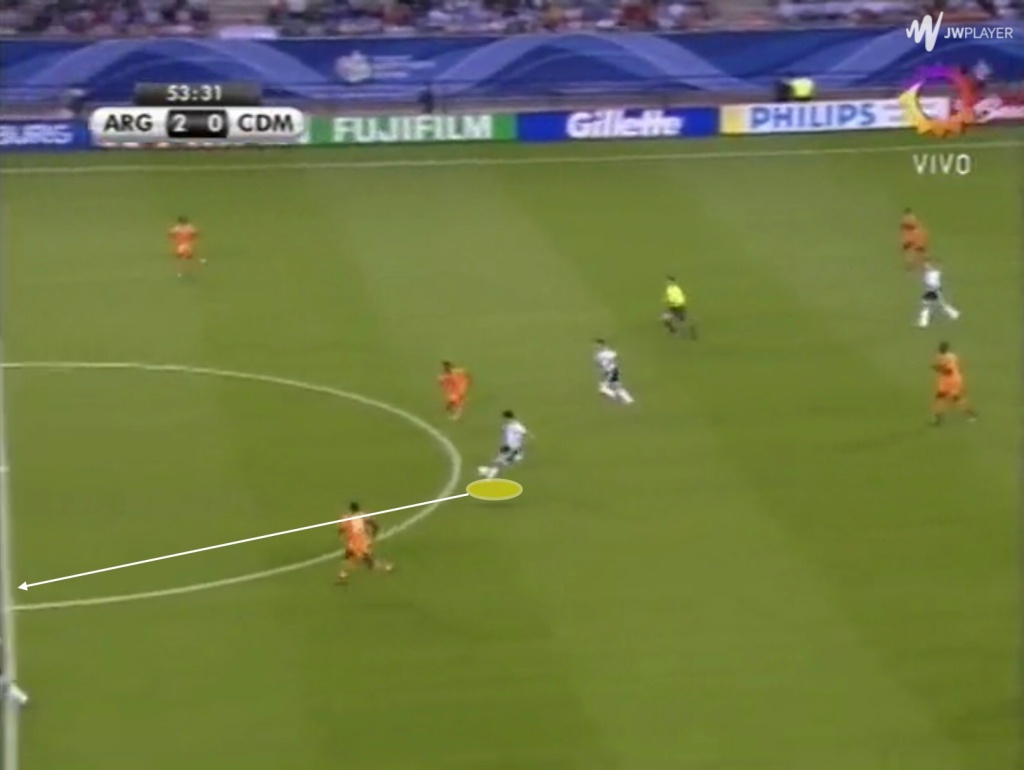
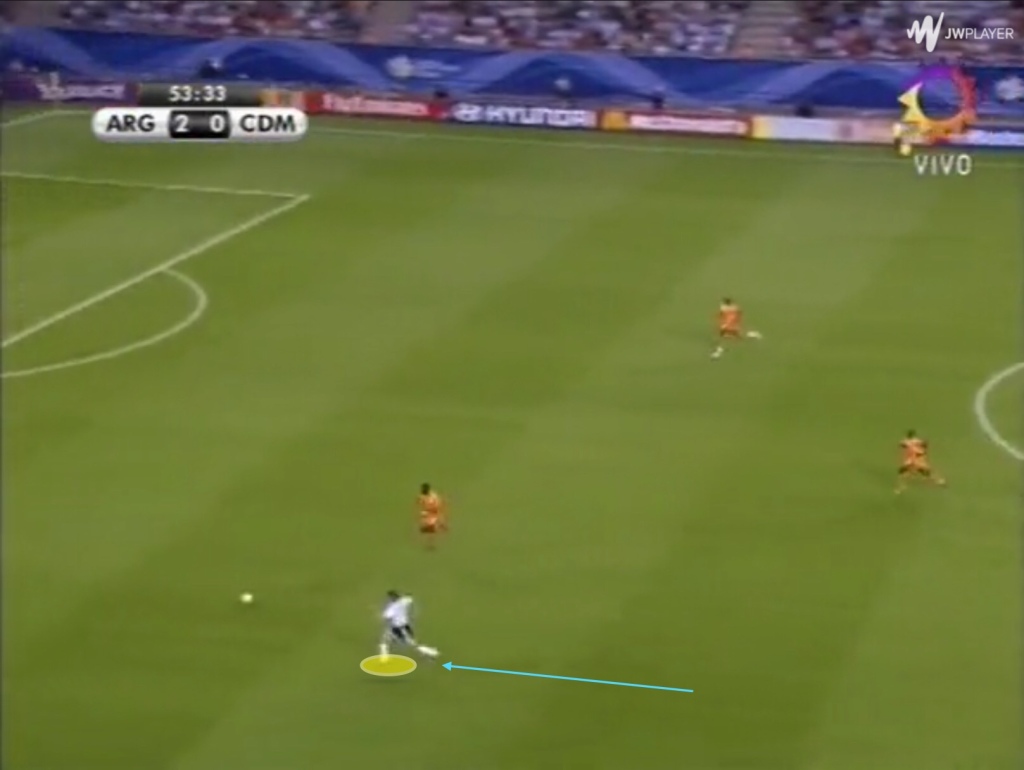
This only continued in an even more impressive display, as Argentina thrashed Serbia & Montenegro 6-0. The system was the same, but Riquelme started the match in a nominally more central position.
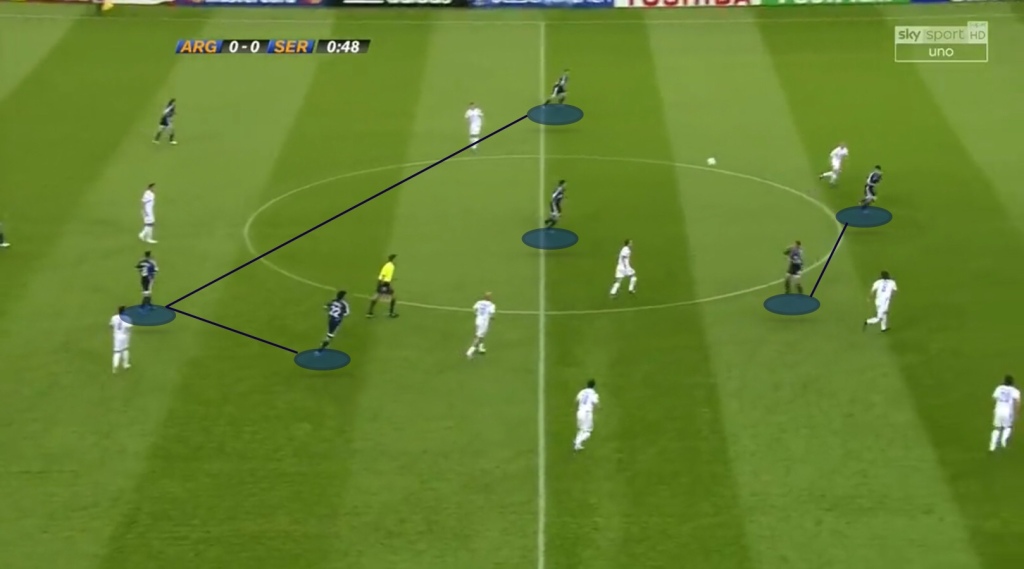
The no.10 continued to be a magnet to the ball, linking play in the lead-up to the first goal. He exchanged passes down the left-side, drawing Serbian players out of space before Maxi broke forward into the box and finished emphatically.
Because Argentina were so dominant, there is less to note on defensively, but midfielders tracked back, and Mascherano dropped closer to the centre-backs, which compensated for Riquelme’s lack of defensive work. This worked in 2006, but questions would be raised 15 years on, with more of an impetus on teams defending as a unit, and less compromise for one player.
Lucho Gonzalez, who started the match, had to be replaced by Cambiasso with only 16 minutes passed. This did not affect the game plan that much, it was a like for like change. And it was the substitute who was on the end of one of the tournaments most memorable goals. A 24-pass move, overseeing patient build-up play, wearing down the Serbian block. Riquelme partook in one-touch exchanges, with Cambiasso running on to a flick from Crespo and converting. Perhaps there is admittedly less need to analyse a goal of this nature, the best thing to do may be to just watch.
Riquelme worked perfectly as an Enganche as well because of how when he would offer a passing option, it was often within triangles which a) could outnumber opposition marking in moving the ball up the pitch and b) was one reason Argentina were effective at carving out chances.
Argentine would also attack in great numbers. With Sorin overlapping, two midfielders making forward runs, Riquelme, and two forwards, Argentina often had six in the final-third. This did allow for combinations in and around the box, as the attack overwhelmed the defence. It also allowed for Riquelme to show off his deft touch and array of flicks and backheels.

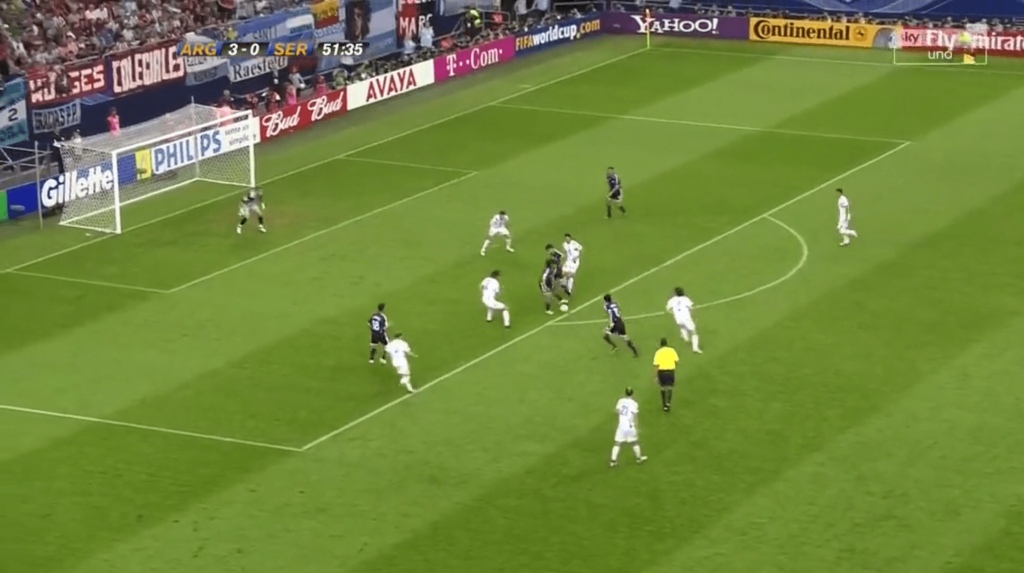
Riquelme brought the ball forward by moving to it and picking out passes. You would think he could take the ball from any area of the pitch, and pick out a pass towards anywhere else on the pitch. And as Argentina attacked, there was good spacing which enhanced both Riquelme as a passing option and the options he had when in possession.
With this in mind, it may have been best for opposing sides at the World Cup to man-mark Riquelme. Riquelme often had too much freedom when in possession, rather than being closed down tightly. Notably against Serbia & Montenegro, there was a large amount of space between the lines.
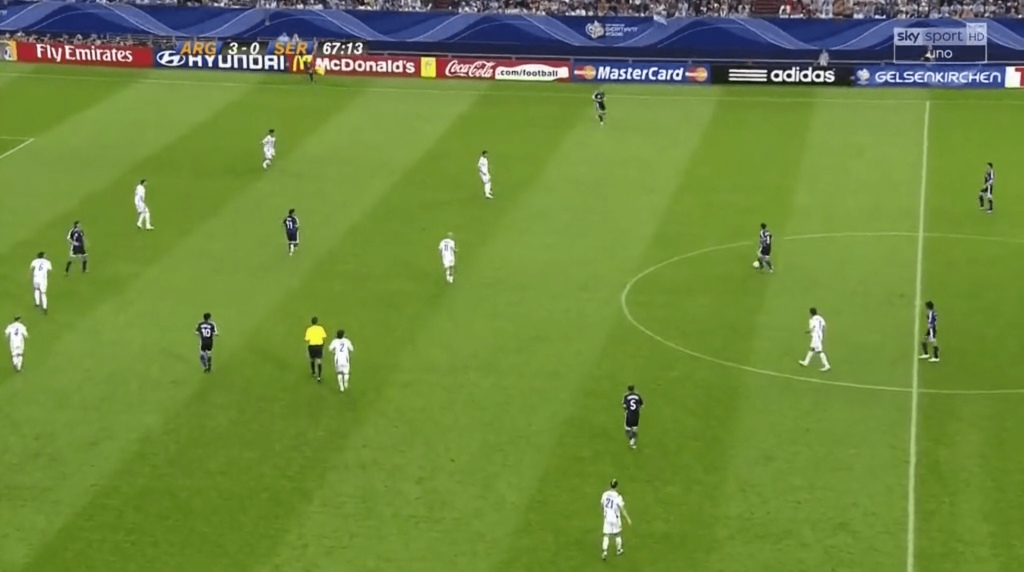
With teams in 2021, even at international level offering more compactness, it may make you wonder if Riquelme would have thrived had he been playing today. Though this is not an attempt to undermine the no.10s quality, as he only continued to create chances.
A recurring theme within Argentina in 2006 was the aforementioned strike duo acting as split forwards drifting wide. Riquelme had the option to go left or right with a pass. And when a forward did receive a pass, they could either drive down the flank and play a ball into the box, or dribble inside and force the defence back, even shooting towards goal. An example of this was Argentina’s fifth goal, scored by Tevez.
Tevez moved wide left, and was found by a pass from Riquelme from the centre. Tevez cut inside, nutmegging one defender and knocking it past another, before slotting the ball into the bottom left corner. These sorts of runs made tested defences, and not much was done to combat them in the opening two group games.
In the final group game against The Netherlands, which ended goalless, both sides rested players, with Tevez and Messi now starting up front. The Dutch did more than both previous sides to combat the movement from the forwards, but even with this, Riquelme was still able to threaten with passes from open play and set-pieces.
Although it can be argued Riquelme was hampered by at times spending too much time on the ball, it did give others time to join attacks. And this was evident against Mexico in the Round of 16. Riquelme again found the runs of teammates too, notably setting up Saviola, but the latter shot too close to the goalkeeper Oswaldo Sanchez.
After Mexico initially took the lead, it was Riquelme’s corner which was headed goal bound, but funnily enough by Mexico forward Jared Borgetti, even though Crespo was awarded the goal.
The game was well-fought out, with it going to extra-time. Maxi Rodriguez stole the headlines with a fantastic volley to cement Argentina’s place in the Quarter-Finals, but Riquelme did show how, at least based on displays at the World Cup, he was one of the best there has been at retaining possession and maximising its threat with passes.
Hosts Germany offered a tighter press without the ball. Germany respected Riquelme more in the sense that he did have less room to turn. The match itself was also cagey, with both Germany and Argentina making 23 and 30 fouls respectively. But this did not stop Riquelme entirely, and his delivery from a out-swinging corner assisted Roberto Ayala to hand Argentina a temporary lead. Argentina averaged a goal every 41 minutes when Riquelme was on the pitch at that World Cup.
Riquelme’s eventual substitution perhaps supported the overall notion of the tournament, and fate of the classic no.10. Tactics were prioritised over players, and as time passed, the classic no.10 became more and more a declining commodity.
Zinedine Zidane had his last hurrah, and was awarded the golden ball, even after receiving the now infamous red card. Francesco Totti, who started as a no.10 in the final between Italy and France, was eventually taken off too. Pablo Aimar, yet another coveted Argentinian Enganche, was only second fiddle to Riquelme, and only made substitute appearances.
Argentina could easily look at this tournament as one of failure, but also one that brings back memories of some excellent displays in the early rounds, and a prime Riquelme provide creativity in abundance.
Images: footballia.com, FIFA